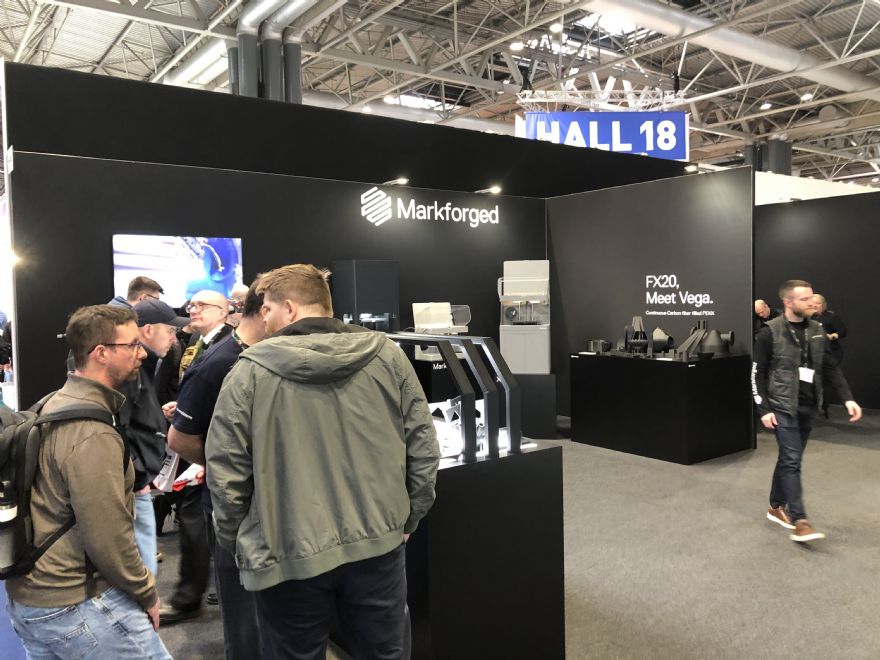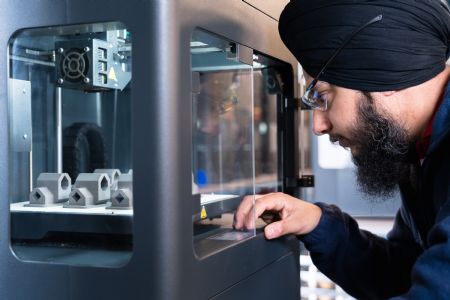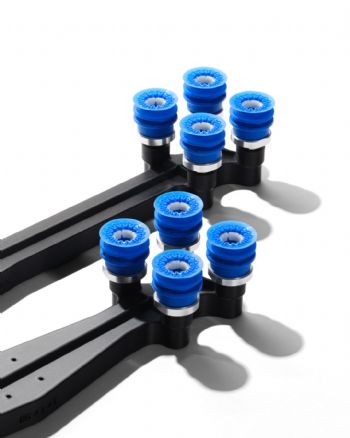 The Markforged stand at MACH 2024. Picture: John Hunter
The Markforged stand at MACH 2024. Picture: John HunterUS-based
Markforged is the creator of the integrated metal and carbon fibre additive manufacturing (AM) platform, the Digital Forge. Daniel Leong, senior product marketing manager (pictured below), spoke with
Machinery Market at the recent
MACH 2024 exhibition to explain that on-demand manufacturing is already a reality within industries where quick access to spare parts presents the opportunity to gain a potential competitive advantage. Sectors including rail, defence and automotive are leading the way, making the most of technologies like AM in order to localise production by 3-D printing spares, tooling and products whenever and wherever they are required.
With benefits ranging from de-risking supply chains, to reducing waste and saving costs with digital inventories — not to mention customising and creating bespoke products to suit customer needs — on-demand manufacturing is changing the way that the manufacturing industry ticks. So why isn’t everyone using it?
Where a global supply chain once meant greater access to the right materials, technology and talent, current economic and geopolitical challenges have started to turn what were once deemed benefits into obstacles. While working across borders still has huge benefits when it comes to ideas and innovation, businesses have learned from the past few years that reshoring some of their manufacturing can help speed up time-to-market.

Mr Leong said: “With longer supply chains continuing to be vulnerable to delays and risks, we have seen on-demand manufacturing circumvent these issues time and again — keeping things moving on the factory floor. Companies like
Deutsche Bahn (DB) have built on-demand into their repair and maintenance cycles to speed up repairs — saving time, costs and resources. The rail giant produced its 100,000th 3-D printed spare part last spring and has a ‘digital warehouse’ containing virtual files of spare parts, which DB plans to increase from 1,000 to 10,000 by 2030.”
He continued: “AM is making digital inventories a reality across a range of industries. Technologies like Markforged’s Digital Forge allow companies to print the components they require, when and where they need them. This not only helps to speed up repair cycles and response times, but can lower the high economic and environmental cost of long-distance shipping as well as reducing waste and storage costs.”
In addition to digital inventories and maintenance, on-demand manufacturing is also changing the way parts and products are designed. Product design can be optimised with greater flexibility in mind — and thanks to AM, it allows for customisation to suit specific customer requirements. It can also incorporate more complex geometries than traditional manufacturing methods, allowing for stronger, lighter weight structures, which are especially beneficial in industries such as automotive and aerospace when it comes to reducing carbon emissions. Additionally, the localisation of production through on-demand manufacturing reduces transportation-related carbon footprints and waste, contributing to environmental sustainability.
Creating custom prosthetics on-siteMr Leong explained: “The digital nature of on-demand manufacturing also encourages collaboration across departments, borders and industries — enhancing designs, skills and helping to create a more agile and flexible workforce. It is thanks to this technology and collaboration that we are seeing local automotive service centres 3-D printing parts on-demand to service cars, hospitals and surgeries creating custom prosthetics on-site and innovations like bicycle tyres that never go flat become a reality. Industries like footwear are also turning to on-demand to create custom designs as well as reshore their manufacturing and reduce waste by creating fewer shoes — manufacturing for demand rather than stock.”

He added: “It is important to note that while the possibilities and benefits of on-demand manufacturing are clear and far-reaching, it is not suitable for all means of production. Rather than eliminating global supply chains, it serves to make them shorter and less vulnerable, more efficient and more innovative.”
Mr Leong pointed out that it still has a long way to go before it reaches critical mass, however. Sharing success stories and innovations like those above plays a big role in helping to overcome the uncertainty, fear of change and inertia that slow the transformative power of nearly all new technologies. In addition to the challenges of behavioural change, there are still obstacles to overcome when it comes to the widespread adoption of on-demand manufacturing. These are highlighted below, along with how technologies are helping to address them.
Scalability and production capacity: On-demand manufacturing works well for smaller scale manufacturing and production, but as demand and production volumes grow, it is crucial that production capacity, equipment, and the workforce can handle larger orders as well as maintain and deliver consistent quality. AM can help companies to scale their production volumes up and down, as well as incorporate quality assurance and repeatability.
Digital infrastructure, connectivity and security: On-demand manufacturing heavily relies on digital technologies and connectivity. Companies need efficient digital infrastructure, including robust CAD systems, digital communication platforms, and secure data transfer. Government initiatives like
Building Digital UK and the
Digital Economy and Society Index (DESI) in the European Union (EU) are helping to extend robust, high-speed broadband and infrastructure to increase and ensure greater connectivity for individuals and businesses.
Furthermore, emerging technologies like blockchain are helping to ensure the safe transfer of files across borders to help protect proprietary data and intellectual property. As trust in this security grows, so will the adoption of technologies that power the connectivity and facilitate collaboration between the designers, manufacturers, and customers required for on-demand manufacturing to thrive.
 Quality control and certification:
Quality control and certification: Product liability and certification need to be addressed before we can see the widespread adoption of on-demand manufacturing — especially when it comes to regulated industries. This requires collaboration between stakeholders, policymakers, and regulatory bodies. Connected AM platforms like the Digital Forge are integrated with digital tools including AI-powered validation and simulation to help enable a smooth digital workflow and repeatability that is vital for regulatory compliance.Together, we need to develop comprehensive frameworks that balance safety, innovation, intellectual property protection, and environmental sustainability.
Education: Knowledge is power and while investment in digital skills is taking place, there is still a need for upskilling the manufacturing workforce. Engineers, product designers and creatives need to collaborate and work across departments to drive innovation. Industry and educational institutions need to continue to work together through facilities like
Print City and
iAero, providing the hands-on and business-level training needed to help on-demand manufacturing reach its potential.
Mr Leong said: “As with any technology advancement, the cost of on-demand manufacturing will decrease as its adoption increases. Ultimately, its success lies in its ability to benefit its end-users. In addition to helping manufacturers save time and resources and reducing waste and emissions, the true value of on-demand manufacturing lies in its ability to de-risk supply chains and solve problems closer to home.”
He concluded: “By bringing manufacturing nearer to the customers and markets it serves, on-demand means that products can be specifically developed and tailored to meet the needs of local markets, communities and businesses. Its widespread adoption will strengthen manufacturing as a whole, making it more relevant, responsive and resilient when it comes to solving problems on a local — and a global scale.”